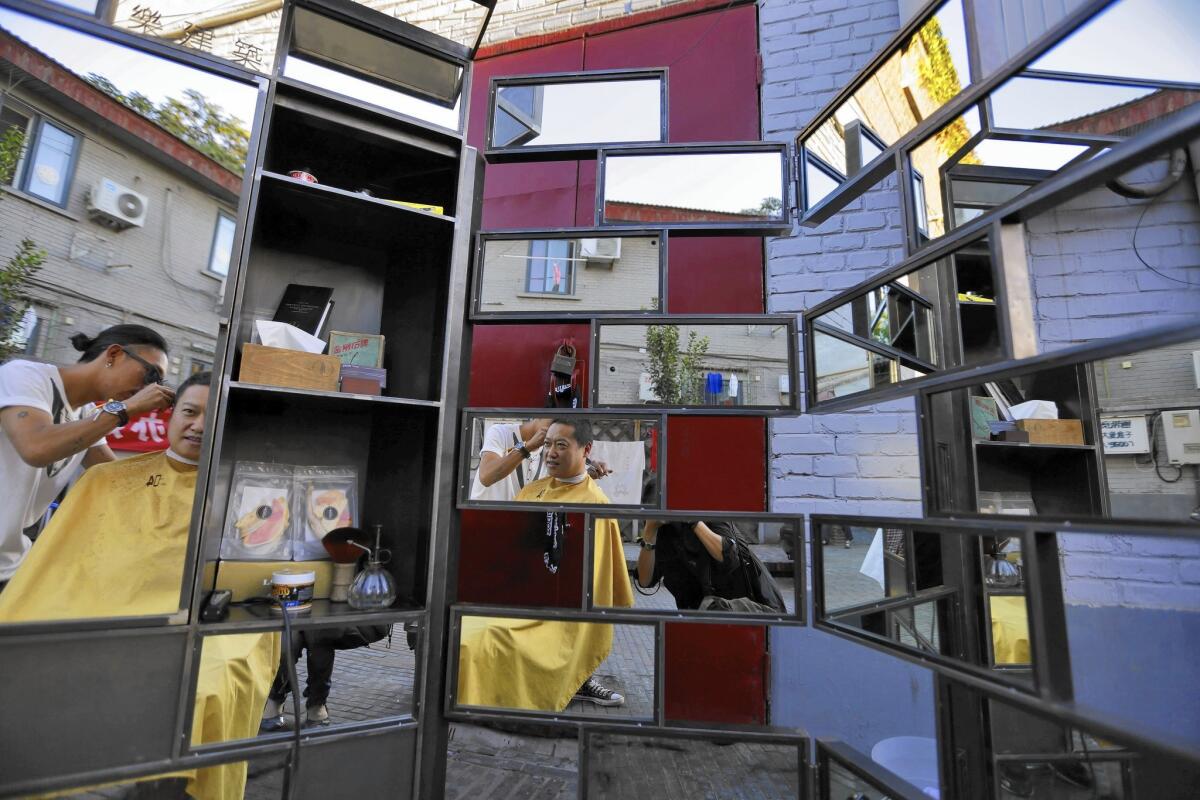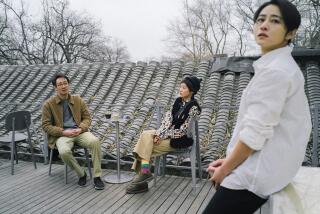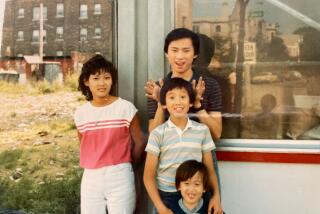Historical now hip in Beijing as young artists gravitate to the hutongs

Hong Kong designer and stylist Jaxx Yuen is reflected in his design work “Hutong Reflection,” built for Beijing Design Week. The event took place in the Dashilar neighborhood, famous for its hutongs, or alleys.
Wang Xiuren’s traditional courtyard house in central Beijing, a short walk from Tiananmen Square, has witnessed the fall of the Qing Dynasty, the Japanese occupation, the Great Leap Forward, the Cultural Revolution and the market reforms of the 1980s and ‘90s.
Then the hipsters came.
On a bright, sunny Sunday in late September, Wang, 62, stood in front of the house, watching a parade of young, affluent writers, artists, designers, architects and foreign tourists amble by, snapping photos of Yangmeizhu Hutong’s high gray walls, vermilion doors and sloping tile roofs. In recent years, Beijing’s creative class has transformed the hutong — or traditional Beijing alleyway — into a warren of cafes, bars and pop-up shops with the trendy, sophisticated air of Williamsburg, Brooklyn or Silver Lake.
“They’re really good at design,” Wang said of her new neighbors. “They’re more cultivated than the locals, and that brings people to the area.”
Wang’s neighborhood, Dashilar — which translates literally to “big stone fence” — is home to some of Beijing’s most vibrant remaining hutongs, with names that hark back to an earlier time: Money Market Alley, Door Frame Alley, Coal Lane. In the 1990s, as the city rushed to modernize, developers destroyed about 600 hutongs a year, displacing an estimated 500,000 residents.
Yet in recent years, government protection programs and rising real estate prices have put the brakes on wholesale demolition, and the earthy, organic feel of hutong courtyard homes — some lacking heat and indoor plumbing — have turned many remaining areas into magnets for the young and hip.
Wang has decided to cash in on the creative boom. Her grown daughter, who lives in Los Angeles, has helped her transform part of the courtyard into a coffee shop, which she hopes to eventually supplement with a museum showcasing her family history.
“I’ve been to Los Angeles, Las Vegas, Miami,” Wang said. “Every year I go to America two or three times. I could live in the U.S., and it would be very nice. But I’d rather stay here and work for something — if I don’t, nobody will know our story.”
If Dashilar has lately seemed even trendier than usual, that’s because Beijing’s fifth annual Design Week is underway — bringing the parade of hipsters to Wang’s alley. The event, which is sponsored by the Beijing city government, runs until next Wednesday, with Dashilar as its de facto command center and spiritual core.
Design Week throws the gentrification process into high relief. Scattered among Dashilar’s ramshackle homes are butcher shops, vegetable markets, offices and schools. Cafes bake kumquat and oatmeal cookies; a bearded man hawks jewelry from the back of a retrofitted flatbed tricycle; and bright yellow captions advertise exhibits with names such as “Elevation,” “BodyMemory Mobile Clinic + Workshop,” and “Craft Inheritance — Woodworking.”
Neill Gaddes, 32, an urban consultant at Dashilar Platform — an “implementation agency for the revitalization of the area” — says that many Design Week participants work full-time jobs, and use the event to showcase their passion projects.
“The first year, we just wanted to get people down here to have a look,” said Gaddes, a New Zealand native. “In 2012, we started to push a bit further, by having forums, and design competitions.” Now the event is citywide, with dozens of exhibits spanning four districts.
Getting Dashilar residents to “have more pride in the area” is one of the event’s goals, Gaddes said. Several works in progress — a prefabricated interior architecture scheme, a shared scooter program — could someday directly benefit the community.
“Local craftsmen in the area, we pair them up with designers,” he said. “We just had a project, where we had a bicycle mechanic guy working with the Central Academy of Fine Arts. They were making jewelry with old bike parts, and they had a little jewelry exhibition. It’s not changing the world or anything, but it’s neat.”
Gaddes said the Chinese government generally supports the event — “they’re really trying to grow this bottom-up, grass-roots development,” he said.
Yet the government’s desire for total control has sometimes clashed with the freewheeling ethos of creative design.
According to organizers, a few days before the event began, an official expressed concern with the name of one exhibition, a photography project called “Beijing Arrivals: Entering the Northern Capital.” The official worried that the term “northern capital” — a direct translation of “Beijing” — implied that the country has multiple capitals, and wanted the line expunged. The organizers had already printed the words on thousands of tourist maps, so spent the next few days working in shifts to redact them with markers.
Dashilar is perhaps a microcosm of Beijing’s own transformation into a hipster mecca. The city now boasts at least half a dozen craft breweries, up from zero only a few years ago. Some brew their offerings with local ingredients, such as sweet potatoes and Sichuan peppercorns.
“I’d like to live in the hutongs, but I can’t find a good one,” said Zhang Mingming, a 28-year-old architect, as he ambled around a courtyard home in the shade of an ancient ash tree. “There are a lot of problems here, like the lack of showers and toilets.”
Zhang said his firm, Standardarchitecture, plans to turn the courtyard into an art school. “We’ll open at the end of this year or the beginning of next,” he said. “We’ll have artists, dancers and designers come here and teach kids.”
Down the street, Duan Baoxi, a 68-year-old carpentry teacher, sat in a small, well-lit studio surrounded by young pupils and piles of sawdust. When asked whether he had frequented any of the chic cafes in his area, Duan shook his head.
“I had a coffee once,” he said — in the 1970s, when a Russian friend treated him to a cup in exchange for a favor. “It was really good!” he said. “I have had coffee once or twice since then, but it came out of a packet.”
He said the experience left him with a strong appreciation for outsiders. “We can learn from each other,” he said, smiling. “It’s a good thing.”
Twitter: @JRKaiman
More to Read
Start your day right
Sign up for Essential California for news, features and recommendations from the L.A. Times and beyond in your inbox six days a week.
You may occasionally receive promotional content from the Los Angeles Times.






